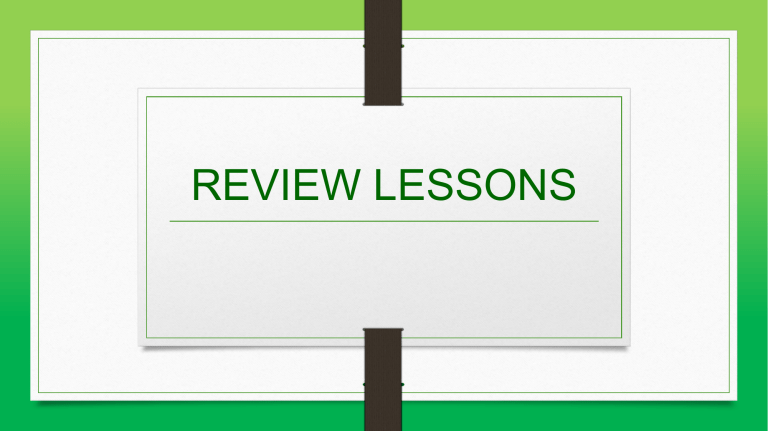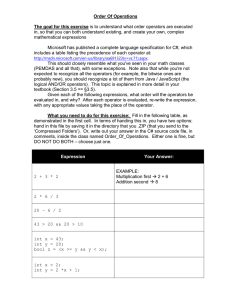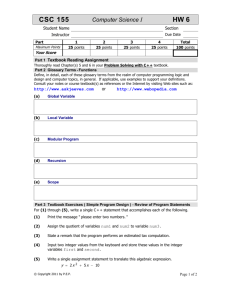
REVIEW LESSONS ORDER OF PRECEDENCE Example • 3* 7 – 6 + 2 * 5 / 4 + 6 Answer: = (((3 * 7) - 6) + ((2 * 5) / 4)) + 6 = ((21- 6) + (10 /4) ) + 6 = ((21 – 6) + 2) + 6 (evaluate *) (evaluate /. Note: that this is an integer division) = (15 + 2) + 6 (evaluate - ) = 17 + 6 (evaluate first + ) = 23 (evaluate first + ) Expressions • Three types of expressions 1. Integral Expressions 2. Floating – Point (decimal expressions) 3. Mixed expressions 1. Integral Expressions • All operands in the expressions are integers • It yields an integral result. Example: 2+3*5 3+x–y/7 x + 2 * (y – z) + 18 2. Floating – Point (decimal expressions) • All operands in the expressions are floating – points ( decimal numbers) • It yields an floating – point result Example: 12.8 * 17.5 – 34.50 x * 10.5 + y – 16.2 3. Mixed Expressions • It contains both integers and decimal numbers Example: 2 + 3.5 6 / 4 + 3.9 5.4 / 2 – 13.6 + 18 /2 How to evaluate a mixed expressions 1. When evaluating an expressions in a mixed a) If the operator has the same types of operands (that is, either both integers or both floating – point numbers, the operator is evaluated according to the type of the operands. Integer operands yield integer results; floating – point numbers yield a floating – point results. How to evaluate a mixed expressions 1. When evaluating an expressions in a mixed b) If the operator has both types of operands (that is, one is integers and the other is a floating – point numbers), then during calculation, the integer is changed to a floating – point number with the decimal part of zero and the operator is evaluated. The result is a floating – point number. How to evaluate a mixed expressions 2. The entire expressions is evaluated according to the order of precedence rules; * , /, and % are evaluated before the +, and – operators - Operators having the same level are evaluated from left to right - Grouping are allowed for clarity. Example Mixed Expressions Evaluation Rule Applied 3 / 2 + 5.5 = 1 + 5.5 = 6.5 3 / 2 = 1 (integer division; Rule 1 (a) (1 + 5.5 = 1.0 + 5.5 (Rule 1 (b) = 6.5) 15.6 / 2 + 5 = 7.8 + 5 15.6 / 2 = 15.6 / 2.0 (Rule 1 (b) = 7.8 7.8 + 5 = 7.8 + 5.0 / 2.0 ( Rule 1 (b) =12.8 = 12.8 4 + 5 / 2.0 4 * 3 + 7 / 5 – 25.5 • Examples illustrate that an integer is not converted to a floating – point number unless to be evaluated has one integer and one floating - point Type of Conversion (Casting) • When was the integer value changed to a floating – point value with a decimal part • Implicit type coercion • Occurred when a value of one data type is automatically changed to another data type • Cast operator (is an explicit type conversion ) use to avoid the implicit type coercion • also called type conversion or type casting Form: • static_cast <dataTypename> (expression) • static_cast it is a reserved word in C++ Expressions Evaluates to static_cast <int> (7.9) 7 static_cast <int> (3.3) 3 static_cast <double> (25) 25.0 static_cast <double> (5 + 3) static_cast <double> (8) = 8.0 static_cast <double> (15) / 2 static_cast <double> (15) = 15.0 = 15.0 / 2.0 = 7.5 Note: • In C++ the cast operator can also take the form dataType(expression). This form is called C-like casting. For example, double (5) = 5.0, and int (17.6) = 17. static cast is more stable than C- like casting. string Type • It is a programmer – define dtype Prior to ANSI / ISO C++ language standard C++ library did not provide a string data type. Compilers vendor often supplied their own programmed – defined string type, and the syntax and semantics of string operations often varied from vendor to vendor. string • Is a sequence of zero and more characters • It is enclosed in double quotation marks • null or empty string refers to string containing no characters; “” is the empty string Example: “William Jacob” “Mickey” “” Variables, Assignment Statements and Input Statements • Two steps of storing data in the computer’s memory 1. Instruct the computer to allocate memory 2. Include statements in the program to put data into the allocated memory Allocating Memory with Constant and Variables • Instruct the computer to allocate memory • name, data type to be store in memory locations • Knowing the data type is crucial for performing accurate calculations • It is also critical to know whether your data needs to remain fixed throughout program execution or whether is should change Named Contants • Use to instruct a program to mark those memory locations in which data is fixed throughout the program execution • It refers to a memory location whose content is not allowed to change during program execution Syntax: const dataType identifier = value; Ex. const double CONVERSION = 2.54; Note • The default type of floating – point numbers is double. Therefore, it you declare a named constant of type float, then you must specify that the value is of type float as follows: const float CONVERSION = 2.54f; float values is 4 bytes double values is 8 bytes Variables • is a location in the computer’s memory where a value can be stored for use by a program Syntax: dataType idenfier, identifier, …; Example: double amoutDue; int x, y, z; char ch; string name; Several Data Types Type Keyword Boolean bool Character char Integer int Floating point float Double floating point double Valueless void Wide character wchar_t Several of the basic types can be modified using one or more of these type modifiers − • • • • signed unsigned short long Data Types, Width and Range Type Typical Bit Width Typical Range char 1byte -127 to 127 or 0 to 255 unsigned char 1byte 0 to 255 signed char 1byte -127 to 127 int 4bytes -2147483648 to 2147483647 unsigned int 4bytes 0 to 4294967295 signed int 4bytes -2147483648 to 2147483647 short int 2bytes -32768 to 32767 unsigned short int Range 0 to 65,535 signed short int Range -32768 to 32767 Data Types, Width and Range Type Typical Bit Width Typical Range long int 4bytes -2,147,483,648 to 2,147,483,647 signed long int 4bytes same as long int unsigned long int 4bytes 0 to 4,294,967,295 float 4bytes +/- 3.4e +/- 38 (~7 digits) double 8bytes +/- 1.7e +/- 308 (~15 digits) long double 8bytes +/- 1.7e +/- 308 (~15 digits) wchar_t 2 or 4 bytes 1 wide character https://www.tutorialspoint.com/cplusplus/cpp_data_types.htm Variables • Each variable has dataType which determine the size and layout of the variable memory • All variables must be declared with a name and a data type before they can be used in a program. • int, double and char are called fundamental types. • Fundamental-type names are keywords and therefore must appear in all lowercase letters. Naming a Variable • A variable name is any valid identifier that is not a keyword • is a series of characters consisting of letters, digits and underscores ( _ ) that does not begin with a digit. • If variable is combination of more than one word, the first letter of each word, except the first word, is uppercase ex. amountDue • C++ is case sensitive —uppercase and lowercase letters are different, so a1 and A1 are different identifiers. Variable Types Type Description bool Stores either value true or false. char Typically a single octet (one byte). This is an integer type. int The most natural size of integer for the machine. float A single-precision floating point value. double A double-precision floating point value. void Represents the absence of type. wchar_t A wide character type. Putting Data into Variables 1. Use C++ assignment operator • In C++, = is an assignment operator int num1, num2; num1 = 4; 2. Use input (read statements) • cin statement uses the input stream object cin and the stream extraction operator, >>, to obtain a value from the keyboard. Example int feet; int inches; cout<< “Enter two integers: “; cin>>feet >> inches; cout<< endl; Increment and Decrement Operators • increment operator (++) • decrement operator (--) Syntax of increment operator (++) Pre – increment : ++variable Post – increment : variable++ Increment and Decrement Operators • increment operator (++) • decrement operator (--) Syntax of decrement operator (++) Pre – increment : --variable Post – increment : variable-- Increment and Decrement Operators C++ Logical Operators • used if we want to compare more than one condition • Depending upon the requirement, proper logical operator is used http://www.c4learn.com/cplusplus/cpp-logical-operator/ C++ Logical Operators Operators && Name of the Operator Type AND Operator Binary || OR Operator Binary ! NOT Operator Unary http://www.c4learn.com/cplusplus/cpp-logical-operator/ C++ Logical Operators Operator Output AND Output is 1 only when conditions on both sides of Operator become True OR Output is 0 only when conditions on both sides of Operator become False NOT It gives inverted Output C++ Logical Operators Truth Table Operator AND OR NOT 1st Condition 2nd Condition Output True True True True False False False True False False False False True True True True False True False True True False False False True – False False – True Activity # 7 • Create a program that will read strings and numeric data Output Enter your FirstName: Name: Enter your Lastname: Age: Enter your Age: Weight: Enter your Weight: Program Styles and Form • Syntax • Rules of a language tell what is legal and what us not legal • It was detected during compilation What is the Ex. int x; //Line 1 int y //Line 2 double z; //Line 3 y = w + x; //Line 4 compilation error? Use of Blanks • Also used to separate reserved words and identifiers from each other and from other symbols • It should be never appear within a reserved word or identifier Semantics • Refers to the set of rules that gives meaning to a language Example is the order of precedence rules for arithmetic operators Both syntactically correct 2+3*5 expressions but they have different (2 + 3) * 5 meanings Naming Identifiers • Example1 Example 2 Self- documenting identifiers it can make comments less Naming Identifiers • annualsale – consider also as self – documenting identifier, but it is called a run-together word • It may lessen the clarity of your documentation • You can capitalize the beginning of each new word or by inserting underscore (_) just before the new word. Ex. annualSale; annual_sale Prompt Lines • Are executable statements that inform the user what to do Ex. cout<<“Please enter a number between 1 and 10 “ <<“ and press the return key” << endl; cin>> num; Documentation • the program should be not only you but also anyone else • A well – documented program is easier to understand and modify • Comments is used to documents programs • It should appear in a program to explain the purpose of the program, identify who wrote it, purpose of particular statements and explain the Form and Style • Different ways to declare variable Form and Styles





